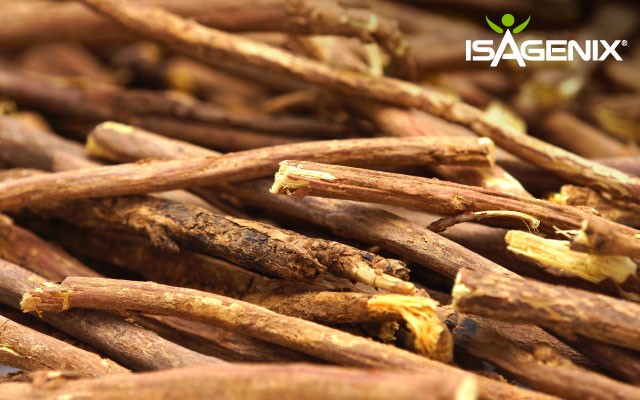Ashwagandha, or winter cherry, is considered one of the most prized Ayurvedic herbs in India, similar to what ginseng is in China. The adaptogen has been used safely for more than 3,000 years in Ayurvedic medicine, a system originated in northern India more than 5,000 years ago (1, 2).
But what is ashwagandha and why is it so popular? The ancient shrub Withania somnifera (L.) Dunal is a small woody shrub, indigenous to Africa, the Mediterranean region, and India (1, 2). It’s a member of the Solanaceae family, a close relative of the potato, tomato, and tomatillo plants (1). Ashwagandha root is classified as rasayana, a Sanskrit word that means: path (āyana) of essence (rasa). It’s widely consumed by women and men, young and old, in a number of Ayurvedic formulas (2, 3).
“The Indian Materia Medica,” (an authoritative book with more than 2,000 natural medicines, most of plant origin,) refers to ashwagandha root as a tonic and strength giver, recommended for children and seniors alike, to promote the nutrition and in cases where general vigor needs to be restored. Ashwagandha builds strength from within (2).
Ashwagandha root is a long taproot and a mass of smaller roots holding clumps of soil when hacked out of the ground in the months of January through March. Once the root is cleaned, it’s cut in longitudinal sticks 2-3 inches long and air-dried. These sticks are ground into a fine powder that can be used as is or extracted with solvents. This delicate traditional processing of the root concentrates the right amounts of withanolides.
Withanolides: Key Components
Withanolides are chemicals in the root with exquisite polycyclic structures, rendering positive effects in the human body. Researchers have discovered a number of phytochemicals in ashwagandha root including alkaloids and a large number of steroidal compounds denominated by withanolides. These chemicals are unique to the plant and used typically as markers to standardize extract potency (3, 5, 10).
Recent human studies confirm that withanolides, ingested either in dried form or in extract form, are responsible for most of ashwagandha’s health benefits (3, 4, 9, 10). These chemicals adjust the body providing an effective way to handle stress, improving quality of life, supporting normal function of the body, building immunity, normalizing cardiorespiratory and neuromuscular coordination, helping cope with fatigue and building strength in men and women. (3, 4, 9)
Withanolides are classified as adaptogens, natural phytochemicals associated with helping the body to resist the effects of stress and key mediators of homeostasis (10).
Safety of Ashwagandha
Ashwagandha has been used by people in different age groups and both sexes without any reported side effects (5, 7, 8). The average amount of dried root consumed in India is 2 grams per day (2, 4, 5), although much larger amounts have been used in extreme cases of emaciation (2). No adverse events or toxicity have been reported when consumed in the short term or on a continual basis (3, 4, 5, 7, 8).
Isagenix Products & Ashwagandha
Isagenix offers several products providing different levels of the adaptogenic benefits of ashwagandha root. These products include Ionix® Supreme, IsaGenesis®, and Cleanse for Life®. The amount of ashwagandha root in one serving of Isagenix products is at safe levels that are well below the average recommended amount of dried root prescribed in Ayurveda.
References
- Biodiversity of India: a Wiki resource for Indian biodiversity. 2010. http://www.biodiversityofindia.org/index.php?title=Withania_somnifera. Accessed October 5, 2017.
- Nadkarni KM, Nadkarni AK. Dr. K. M. Nadkarni’s Indian materia medica: with ayurvedic, unani-tibbi, siddha, allopathic, homeopathic, naturopathic & home remedies, app. & indexes. 3 ed. Bombay, India: Popular Book Depot; Popular Prakashan; 1982.
- Edwards, S., I. da Costa-Rocha, E.M. Williamson and M. Heinrich, Withania somnifera (L.) Dunal (Solanaceae) Phytopharmacy – an evidence-based guide to herbal medicines. Wiley, Chichester, 2015, 32-35
- Williamson E. Withania somnifera (L.) Dunal (Solanaceae) In: Major Herbs of Ayurveda. Churchill Livingstone; 2002, 321-325.
- Health Canada, Withania somnifera (L.) Dunal (Solanaceae) Monograph, 2007, http://webprod.hc-sc.gc.ca/nhpid-bdipsn/monoReq.do?id=35. Accessed October 5, 2017.
- Rondanelli M, Miccono A, Peroni G, et al. A systematic review on the effects of botanicals on skeletal muscle health in order to prevent sarcopenia. Evid Based Complement Alternat Med. 2016;2016:5970367. doi: 10.1155/2016/5970367.
- Sharma, S. Dahanukar, S.M. Karandikar. Effects of long-term administration of the roots of ashwagandha and shatavari in rats. Indian Drugs. 1985;133–139.
- Raut AA, Rege NN, Tadvi FM, et al. Exploratory study to evaluate tolerability, safety, and activity of ashwagandha (Withania somnifera) in healthy volunteers. J Ayurveda Integr Med. July 2012;3(3):111-114.
- Joshi Krutika, Swagata Tavhare, Kalpesh Panara, et al, Study of Ashwagandha (Withania somnifera Dunal) Krutika, International Journal of Pharmaceutical & Biological Archives 2016; 7 (1): 1- 11.
- White P.T., Subramanian C., Motiwala H.F., Cohen M.S. (2016) Natural Withanolides in the Treatment of Chronic Diseases. In: Gupta S., Prasad S., Aggarwal B. (eds) Anti-inflammatory Nutraceuticals and Chronic Diseases. Advances in Experimental Medicine and Biology, vol 928. Springer, Cham, https://doi.org/10.1007/978-3-319-41334-1_14.ashwas





